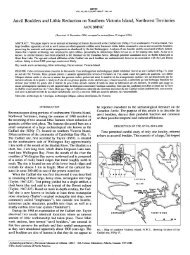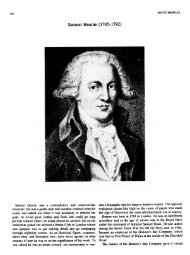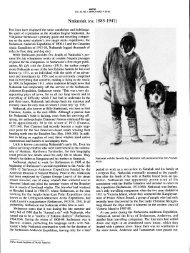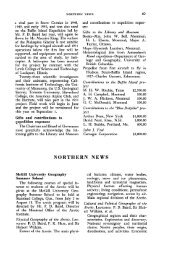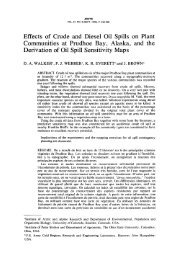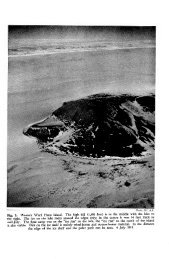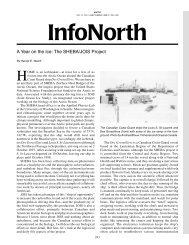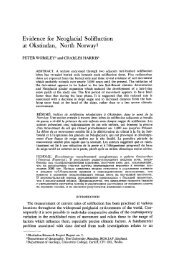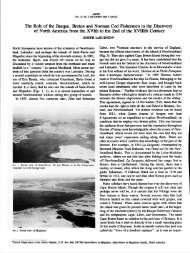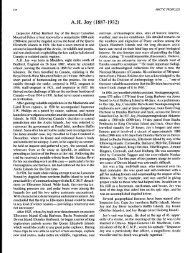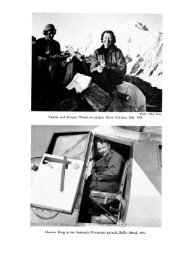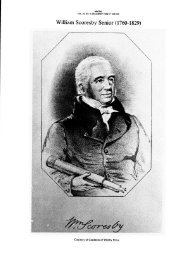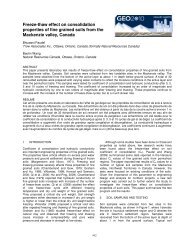To Make These Tribes Understand - AINA Publications Server
To Make These Tribes Understand - AINA Publications Server
To Make These Tribes Understand - AINA Publications Server
You also want an ePaper? Increase the reach of your titles
YUMPU automatically turns print PDFs into web optimized ePapers that Google loves.
The Mounted Police detachment on Herschel Island was kept<br />
open, however, since its purpose in the first place was not<br />
really to watch over whalers or protect the Inuit. The post was<br />
there to show the flag—to proclaim the sovereignty of the<br />
Canadian government over the western Arctic. Because significant<br />
areas of the Arctic had been explored by non-<br />
Canadians, particularly Scandinavians, Canadian sovereignty<br />
had to be based on occupation and administration rather than<br />
on claims arising from discovery. It was for this reason that<br />
other detachments were built in the central and eastern Arctic<br />
after World War I, extending the nominal authority of Ottawa<br />
over regions as remote as the Bache Peninsula, in central<br />
eastern Ellesmere Island, which at 79˚N latitude was the most<br />
northerly police post in the history of the police, and the most<br />
northerly post office in the world at that time. Although mail<br />
delivery was only once a year, and there were only two police<br />
and an Inuit family as residents, the existence of the place was<br />
an important manifestation of sovereignty.<br />
A crucial demonstration of sovereignty in the Canadian<br />
North was enforcing the criminal law on the indigenous<br />
people. In the Arctic, the federal government and the police<br />
were at first inclined to take a lenient view of Inuit who broke<br />
the law. The official view was, sensibly, that it was unreasonable<br />
to expect the Inuit to obey the law before they had been<br />
told what it was, and in any case, the police in particular took<br />
a benign view of the Inuit in the early contact period, finding<br />
them cheerful, helpful, and accepting of authority (Morrison,<br />
1985).<br />
Whatever views the Mounted Police held on the Inuit as<br />
individuals, however, their duty lay in enforcing the political<br />
will of the federal government, and it was Ottawa’s wish that<br />
its sovereignty be emphasized in the Arctic through enforcement<br />
of the law. Such enforcement was not an easy task, for<br />
the distances were huge, and the land only newly discovered<br />
by Europeans—as late as 1914, members of the Canadian<br />
Arctic Expedition met groups of Inuit in the central Arctic<br />
who had never (or only very recently) met a non-Inuit<br />
(Condon, 1996:49). A third difficulty was the unusually high<br />
rate of violence and murder among the central Arctic Inuit. As<br />
Sidney Harring (1989) points out, the contact period, roughly<br />
1910 to 1920, saw six Europeans and about forty Inuit<br />
murdered among the Copper Inuit, and all this violence took<br />
place in a community of 700.<br />
The official attitude at first was to deal leniently with these<br />
people, but when the violence continued, the official attitude<br />
hardened. Three cases show this change. In June 1912, two<br />
explorers, H.V. Radford, an American with northern experience,<br />
and George Street, a young man from Ottawa, were<br />
killed by Inuit at the southern end of Bathurst Inlet, apparently<br />
because Radford, who was notoriously bad-tempered,<br />
had threatened and struck an Inuit man who was acting as<br />
their guide. The police sent out an expedition to investigate;<br />
the group ran into difficulties, and it was not until the winter<br />
of 1917–18, when the crime was nearly six years old, that<br />
they obtained solid information about it (Morrison, 1985:<br />
136–137). The government accepted the fact that the Inuit, in<br />
killing these men, were simply following their own law and<br />
INUIT TRIAL AT HERSCHEL ISLAND • 221<br />
tradition, and the expedition to find the men responsible was<br />
more one of exploration than of punishment. They seem<br />
never to have contacted the actual killers, but did reach their<br />
families, and explained to them the error of their ways and<br />
warned them that Canadian law was now to be obeyed.<br />
Late in 1913, two Oblate priests, Fathers Rouvière and<br />
Le Roux, were killed under similar circumstances near<br />
Bloody Falls on the Coppermine River (the site was named<br />
not for this murder, but for an incident 140 years earlier,<br />
when Samuel Hearne’s Indian guides had killed a band of<br />
Inuit there). Le Roux had threatened one of the Inuit<br />
guides, and both men were killed by Sinnisiak and Uluksuk.<br />
In this case, the police located the killers fairly quickly; the<br />
episode became known in 1914, a patrol was sent out in<br />
1915, the killers were contacted and arrested in 1916, and<br />
the men were brought south for trial in 1917. <strong>To</strong> the<br />
astonishment and chagrin of the Mounted Police and the<br />
Oblate order, there was public feeling that priests who<br />
disturbed the primitive innocence of Inuit had got what<br />
they deserved, and Sinnisiak and Uluksuk, on trial in<br />
Edmonton in the summer of 1917 for the murder of Father<br />
Rouvière, were acquitted. Only when they were subsequently<br />
tried in Calgary for the murder of Father Le Roux<br />
was a conviction obtained (Moyles, 1979).<br />
Sinnisiak and Uluksuk were convicted of murder, but in<br />
keeping with the government’s policy of educating the Inuit<br />
to obey the law, they received a light punishment. They were<br />
sentenced to life imprisonment at the police detachment at<br />
Fort Resolution, Northwest Territories, and were not confined,<br />
but were employed in doing odd jobs around the post.<br />
When the Tree River detachment was established in 1919,<br />
they were employed as dog team drivers. They were released<br />
and permitted to return to their band after two years, by which<br />
time they had acquired a certain arrogance and enough<br />
surplus goods from the police to make them rich men in their<br />
communities. As several contemporaries remarked, this episode<br />
showed bad judgement on the part of the authorities,<br />
who left an impression with the Inuit that crime was taken<br />
lightly by the government, or even rewarded (Morrison,<br />
1985:159).<br />
When the third set of murders occurred, therefore, the<br />
authorities were no longer in a forgiving mood, especially<br />
since one of the victims was a Mounted Policeman. The<br />
detachment at Tree River had recently been set up as a<br />
demonstration of sovereignty and the government’s determination<br />
to enforce the law in the Coppermine-Coronation Gulf<br />
region (Fig. 1). The post showed the clear desire to “prevent<br />
murders of whites and to stabilize commercial and government<br />
activity in the Arctic” (Harring, 1989:7), which was<br />
what sovereignty was chiefly concerned with in that era. The<br />
Tree River post was manned by two members of the<br />
RCMP—Constable D.H. Woolams and Corporal W.A.<br />
Doak, who was in command. The three other white men<br />
there were employees of the Hudson’s Bay Company,<br />
which had a post at Tree River.<br />
In December 1921, Corporal Doak, accompanied by Inuit<br />
employees of the police, made a patrol to Kent Peninsula to



